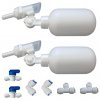JSB99
Well-Known Member
I have an ultrasonic cool mist humidifier that I use to help keep my room cool.
It has a one gallon water reservoir and it'll run a day between fills. What I want to do is have a 5-gallon bucket continuously feed the humidifier reservoir so I only have to fill it once a week.
I tried to set this up with another humidifier I had but I couldn't get it to work. Here's what I did...
Drilled a hole in the 1 gallon reservoir and mounted a bulkhead to it so it's sealed.
Did the same with the 5-gallon bucket.
After filling the bucket and securing the airtight lid, I opened the valve so let the water flow to the 1-gallon reservoir
Water started seeping heavily from the bottom of the 1-gallon reservoir on the humidifier.
I thought by having everything sealed it would maintain the vacuum and only allow water from the 5-gallon bucket to flow once the water from the 1-gallon reservoir dropped below the point where the water dropped below the pvc pipe feeding it.
You ever seen one of those dog water bowls with the 3-gallon water container on the back? You'll notice that the water from the reservoir doesn't empty as long as the tip of the reservoir has a seal with the water in the bowl. Once the water in the bowl drops a little it creates a little air gap between the reservoir and the water in the bowl. The water from the reservoir starts flowing until a seal is created again.
This is what I was trying to accomplish with the humidifier.
Are there any hydrodynamic geniuses out there who can help me set this up correctly?
It has a one gallon water reservoir and it'll run a day between fills. What I want to do is have a 5-gallon bucket continuously feed the humidifier reservoir so I only have to fill it once a week.
I tried to set this up with another humidifier I had but I couldn't get it to work. Here's what I did...
Drilled a hole in the 1 gallon reservoir and mounted a bulkhead to it so it's sealed.
Did the same with the 5-gallon bucket.
After filling the bucket and securing the airtight lid, I opened the valve so let the water flow to the 1-gallon reservoir
Water started seeping heavily from the bottom of the 1-gallon reservoir on the humidifier.
I thought by having everything sealed it would maintain the vacuum and only allow water from the 5-gallon bucket to flow once the water from the 1-gallon reservoir dropped below the point where the water dropped below the pvc pipe feeding it.
You ever seen one of those dog water bowls with the 3-gallon water container on the back? You'll notice that the water from the reservoir doesn't empty as long as the tip of the reservoir has a seal with the water in the bowl. Once the water in the bowl drops a little it creates a little air gap between the reservoir and the water in the bowl. The water from the reservoir starts flowing until a seal is created again.
This is what I was trying to accomplish with the humidifier.
Are there any hydrodynamic geniuses out there who can help me set this up correctly?

